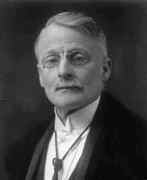◀ ▲ ▶History / 19th-century / Person: Poussin, Charles de la Vallée
Person: Poussin, Charles de la Vallée

Vallée Poussin is best known for his proof of the prime number theorem and his major work Cours d'Analyse .
Mathematical Profile (Excerpt):
- From his boyhood he was encouraged by the mathematician Louis-Philippe Gilbert but at first Vallée Poussin thought he would become a Jesuit priest.
- He was particularly disappointed in the teaching of philosophy at the College, so he turned to a different topic although he still did not have mathematics as his main interest.
- Vallée Poussin also studied at the University of Paris and at the University of Berlin.
- In 1891 Vallée Poussin was appointed as an assistant of Gilbert's at the University of Louvain.
- However the collaboration was not to last for long since Gilbert died in 1892.
- Although only 26 years old at the time Vallée Poussin was elected to Gilbert's chair.
- Vallée Poussin's first mathematical research was on analysis, in particular concentrating on integrals and solutions of differential equations.
- One of his first papers in 1892 on differential equations was awarded a prize by the Belgium Academy.
- His best known work, however, appeared four years later in 1896 when he proved the prime number theorem.
- The prime number theorem had been conjectured in the 18th century, but in 1896 two mathematicians independently proved the result, namely Hadamard and Vallée Poussin.
- The first major contribution to proving the result was made by Chebyshev in 1848, then the proof was outlined by Riemann in 1851.
- The clue to two independent proofs being produced at the same time is that the necessary tools in complex analysis had not been developed until that time.
- The solution of this major open problem was one of the major motivations for the development of complex analysis during the period from 1851 to 1896.
- Other than the prime number theorem, Vallée Poussin's only contributions to prime numbers were contained in two papers on the Riemann zeta function which he published in 1916.
- Vallée Poussin strengthened results proved by Hardy in 1914 which showed that an infinite number of the zeros were on that line.
- Vallée Poussin's results were of passing interest, however, for Hardy and Littlewood proved still stronger results in 1918.
- Vallée Poussin also worked on approximation to functions by algebraic and trigonometric polynomials from 1908 to 1918.
- Let us define first what we mean by approximation.
- Vallée Poussin's most major work was Cours d'analyse .
- If Jordan's is the most noble of the Cours d'Analyse and perhaps Goursat's (helped by its translation by Hedrick) the most widely read, it can hardly be doubted that Vallée Poussin's is the most elegant and lucid.
- Vallée Poussin's Cours d'analyse Ⓣ(Analysis Course) went through several editions, each containing new material.
- If a reader only read the larger type then it was a complete introduction to the subject for beginners or those interested in applications to engineering.
- The smaller type material was aimed at the pure mathematical specialist interested in the deeper subtleties.
- Most of the additional material appeared in small type and covered topics such as set theory, in particular the Schröder-Bernstein theorem, the Lebesgue integral, functions of bounded variation, the Jordan curve theorem, polynomial approximation, Parseval's theorem on trigonometric series, results of Fejér, etc.
- The promised German translation failed to appear and the third edition of Volume 2 was burned by the German army when it overran Louvain.
- It would have discussed the Lebesgue integral, work which was never to be published in this form but a lot of it was incorporated into a later monograph.
- Unlike many similar books of its time Cours d'analyse Ⓣ(Analysis Course) contains no complex function theory.
- It ended the larger/smaller print distinction and became a work aimed at beginners.
- After 1925 Vallée Poussin turned to complex variable, potential theory and conformal representation.
- In 1930 Vallée Poussin was revising his 1916 tract Lebesgue integrals: Set functions: Baire classes when Luzin's Lectures on analytic sets and their applications was published.
- Vallée Poussin comments in these letters on the fact, which is of great interest to him, that Luzin used slightly different classifications of the same sets as he had studied.
- Vallée Poussin was elected to the Belgium Academy in 1909.
- More honours were to follow including election to the Madrid Academy of Sciences, the Naples Society of Science, the American Academy of Arts and Sciences, the Institute of France, the Accademia dei Lincei, the Paris Academy of Science, and the American National Academy of Sciences.
- There were celebrations in 1928 when Vallée Poussin had held the chair at the University of Louvain for 35 years and again celebrations in 1943 when he had been 50 years in the chair of mathematics at Louvain.
- In 1928, when he had held the chair at Louvain for 35 years, the King of Belgium conferred the title Baron on Vallée Poussin at the celebrations for this event.
- In 1961 he fractured his shoulder and since Vallée Poussin was in his mid 90s it failed to heal.
- His death followed a few months later.
Born 14 August 1866, Louvain, Belgium. Died 2 March 1962, Louvain, Belgium.
View full biography at MacTutor
Tags relevant for this person:
Origin Belgium, Number Theory, Puzzles And Problems, Special Numbers And Numerals, Topology
Thank you to the contributors under CC BY-SA 4.0! 

- Github:
-

- non-Github:
- @J-J-O'Connor
- @E-F-Robertson
References
Adapted from other CC BY-SA 4.0 Sources:
- O’Connor, John J; Robertson, Edmund F: MacTutor History of Mathematics Archive
